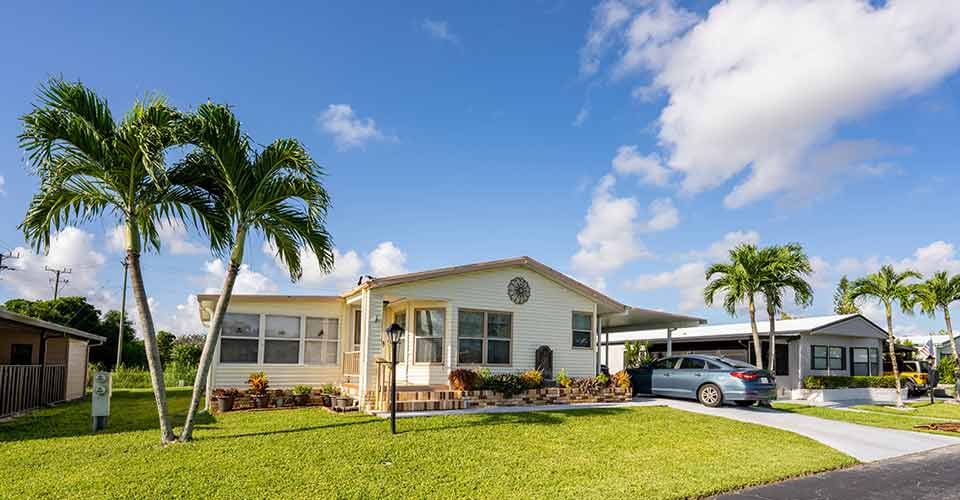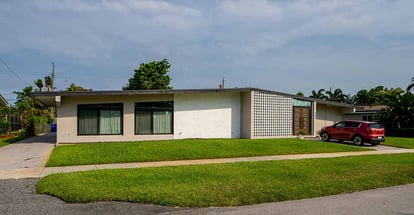New Construction Manufactured Homes - The Complete Guide
Financing a new construction manufactured home can be challenging since the loans aren't plenty compared to standard home loans.
However, you can get the loans from government-backed loan programs like Fannie Mae, Freddie Mac, VA, and USDA. These financing sources have less strict eligibility requirements and can help keep the construction costs low.
Most people prefer new construction manufactured homes because they give you more flexibility regarding costs and construction materials.
When getting a loan to build one, the lender will require the home's detailed cost estimates. You should give your income and credit details to get approved.
You'll probably need a new construction manufactured home loan to cover the construction of the property and the accompanying mortgage. This type of financing saves you time and unnecessary paperwork and enables you to settle closing costs once.
Learn more about new construction manufactured homes and the loan requirements you need to meet below:
What is a New Construction Manufactured Home?
New construction manufactured home is built from scratch from the factory and ferried to the proposed home site.
The site should be ideal to hold the structure and comply with all federal, state, and local codes. The manufactured home must be less than one-year-old and never have any occupants.
Your new construction manufactured home will only qualify for financing if permanently linked to utilities. It must also be categorized as real property.
When seeking financing through government-backed programs, note that each agency has its own definition for this kind of home.
Fannie Mae and Freddie Mac will only approve your application if the home was bought directly from a developer or retailer and has never had any occupants. The structure also needs to be attached to a permanent ground.
FHA considers a manufactured home to have been permanently affixed on a foundation for less than a year since it was assigned a case number. The property must meet Standard FHA Manufactured Home Guidelines to qualify for financing.
VA requires the manufactured home's construction to meet HUD's Manufactured Home and Construction and Safety Standards.
It must also adhere to all local and state requirements. For USDA, the new construction manufactured home must be less than 12 months old on a permanent site with no occupants.
Construction Stages
New construction manufactured homes have to fall in three different construction stages before they are ready for occupation. These stages include proposed construction, under construction, and existing construction.
Under the proposed construction stage, the property will have no permanent materials or concrete to define it. In this stage, the digging of the foundation and placement of the rebar isn't permanent.
The under-construction phase is when permanent material is first placed on the structure. The property will go from zero to 100 percent completion in this stage. However, it won't have any Certificate of Occupancy or an equivalent.
Under the current construction phase, the property must be less than a year old. It should also be 100 percent complete and must have a Certificate of Occupancy or an equivalent. The home shouldn't have any occupants too.
Fannie Mae Requirements
The new construction manufactured home must be newly constructed to be considered under Fannie Mae's financing programs.
The property should be your primary and second home residence for a standard Fannie Mae loan program. The Home Ready program by Fannie Mae will only consider the property for financing if it is your primary residence.
You can use purchase money transactions to finance the purchase of the manufactured home with the land or the manufactured home alone.
Fannie Mae even allows you to take the loan if you previously owned the land and don't have any existing mortgage obligations.
The home's sales price may include site documented and bona fide site preparation, dwelling installation, and transportation.
If the home comes with any personal property items, these items should be subtracted from the sales price. It isn't easy to finance them as part of the home loan.
Determining Value to Calculate LTV
The LTV ratio for a Fannie Mae-backed home loan secured by a newly constructed manufactured home is based on various factors. It depends on the lower of the property's sales price plus the current land value.
The land's lowest sales price would be applicable if sold 12 months before your loan application. Its current appraised value will be used if the land was bought over 12 months before you applied for the loan.
Freddie Mac Requirements
You can get a Freddie Mac-backed loan for new construction manufactured homes under certain conditions. First, the purchase transactions must exclusively be meant for primary and second residence homes. Second, cash-out refinances will not be allowed.
The loan proceeds may help you buy the land (though you can own the land separately). You can also use them to pay costs for transportation and set up site preparation, installation, and utility connections, provided you document them.
Your loan file underwriting must consist of a copy of the Manufactured Home Purchase Agreement and Manufacturer's Invoice. Your lender should also submit the loan through Freddie Mac's Loan Prospect Advisor and get a valid Accept/Approve response.
What's Included in the Purchase Price?
The home's purchase price should include documented delivery and setup costs. It should also comprise documented costs for site development, installation, and permanent utility connections (including septic systems and/or wells).
If you bought any non-realty items (personal property items) with the new construction manufactured home, it should be subtracted from the sales price. You won't be allowed to finance it as part of your home loan.
Documentation and Appraisal Requirements
Your Freddie Mac-backed home loan application will only go through if you submit a copy of the manufacturer's invoice. The loan process also requires you to have a valid Manufactured Home Purchase Agreement and land's Sales Contract (if the buyer doesn't already own it).
During the appraisal stage, the appraiser will analyze your paperwork. They will then report their options, analysis, and conclusions in the form of an appraisal report.
If you own the land, it can be used as an equity contribution in the loan process. The equity contribution would amount to the land's current appraised value if you owned it for more than 12 months before submitting your application.
The equity contribution will also equal the land's lower current appraised value or purchase price if you have owned it for less than 12 months.
If you bought the land less than 12 months before applying for a loan, your equity contribution must be documented along with other paperwork. These documents include a copy of the warranty deed and the Closing/Settlement Disclosure Statement.
You have to present paperwork to verify the acquisition and transfer of land ownership if you acquired the land through a non-purchase transaction like a gift or inheritance. It would be best if you also verified that the land's value is the same as its current appraised value.
Determining Value to Calculate LTV
The loan-to-value ratio for a loan secured by a new construction manufactured home will rely on the lower of the home's purchase price plus the land's value.
If you bought the land less than 12 months before submitting your application, the mortgage lender would use the land's lowest sales price. Consequently, if you bought the land more than 12 months before applying, the land's current appraised value will be applicable.

FHA Requirements
The FHA loan program will only consider your new construction manufactured home for financing if it is permanently affixed on a site and is less than one-year-old. The home should also meet Standard FHA Manufactured Home Guidelines.
During the loan process, documentation required regardless of the loan-to-value ratio includes:
-
Builder's Certification of Plans, Specifications, and Site (Form HUD-92541).
-
Warranty of Completion of Construction (Form HUD-92544).
- Evidence of enrollment or acceptance in a HUD-approved insured 10-year protection plan.
The inspection options for the property should include:
-
Initial and final inspections done by an FHA Roster Inspector.
-
Initial and final inspections done by a certifying architect or engineer.
- Final inspection issued by a certifying engineer or architect or an FHA Roster Inspector.
Are You Allowed to Build the Home on Own Land?
If you are building the home on your own land, you must have owned the land for more than six months before getting a case number. You should also obtain a Closing disclosure or an equivalent to show the date you received the land's title.
The program requires you to liaise with a licensed general contractor (if you're not trained to be one) to construct improvements on the land.
Calculating the Maximum LTV
Your maximum loan-to-value ratio will be based on the property's construction status and the paperwork provided. It will also be calculated based on the standard purchase LTV limits.
These limits include:
-
90.01 to 96.5 percent if you can meet maximum financing requirements for the home and have a 10-year warranty.
-
90 percent if you can't meet the maximum financing requirements and you don't have the warranty (10-year).
-
85 percent if there's proof of identity of interest.
- 75 percent if the application constitutes a co-borrower, non-occupant, or non-related terms.
Appraisal Requirements
For an FHA-backed new construction manufactured home, the lender must issue the appraiser with form HUD-92541. The form should be signed and dated less than 30 days before the ordered appraisal date.
If your home is 90 percent completed, the lender should give the appraiser a copy of the lot and floor plans, among other exhibits. These exhibits will enable the appraiser to determine the home's size and finish level during appraisal.
For homes that are more than 90 percent but less than 100 percent completed, the lender should give the appraiser a detailed list of components to be completed or installed. This list should be issued after the inspection date.
VA Requirements
For a VA-backed new construction manufactured home, the property has to go through stages such as proposed and under construction stages.
The home qualifies for appraisal before or during construction. However, local authorities have to conduct at least two inspections to verify that it is permanently affixed to a foundation.
The appraisal done on the home needs to identify all specifications and plans used during the appraisal. If a model home helped guide the specifications and plans of the home, its details should be identified.
New construction manufactured home that is less than one-year-old can qualify for the financing if it has no occupants.
It will be considered complete even without floor coverings, interior wall finishes, appliances, escrow-permitted improvements, and fixtures and equipment.
The VA requires all loan origination functions to be conducted via the WebLGY portal. Lenders can request an appraisal from this portal and obtain COEs (Certificates of Eligibility).
Staff Appraisal Reviewers can also issue NOVs (Notice of Values), and Loan Guaranty Certificates can be generated.
Properties not Eligible for VA Appraisal
New construction manufactured homes based in a Special Flood Hazard Area or an area that experiences regular flooding won't qualify for a VA appraisal. Other factors that make the home ineligible for the appraisal include:
-
An area prone to soil or geological instability.
-
Areas with a transmission line easement that involves high-voltage electricity, liquid petroleum, or high-pressure gas.
-
If any party of interest in the sale is excluded or debarred from participating in the Loan Guaranty Program.
- Airport Clear Zone (also known as Runway Protection Zone).
USDA Requirements
The USDA loan program for new construction manufactured homes only qualifies homes less than 12 months old from their manufactured date.
You can find the manufacture date on a plate affixed to the unit. The home should not have had any occupants and must be based on a compliant site.
USDA loan proceeds can help you buy, transport, and set up an eligible new manufactured home unit. They can also help you buy an eligible site if you don't own one.
Standard USDA-specific requirements for a newly constructed manufactured home include:
-
Less than 600 square feet in area.
-
HUD Certification label attached to the home's interior and exterior.
- The home must be categorized as real property once you buy it.
USDA Property, Construction, and Site Requirements
Your newly constructed manufactured home can only qualify for USDA-backed financing if it meets the following property requirements:
-
Single-unit manufactured housing.
-
Non-farm or non-income property.
-
Unit less than 12 months old from its manufactured date to the purchase date.
-
Never occupied.
-
Must be situated in a rural-designated area in the US.
-
Must be located at a USDA Income and Property Eligibility Site.
- Have a copy of the property eligibility determination in the underwriting submission.
If you're applying for the USDA-backed home loan, the loan file should contain the following items:
-
A copy of the certification obtained from a qualified organization or individual that. reviewed paperwork to confirm they adhere to relevant development standards.
- Meet Construction Certified Plans and Specifications complying with all development standards.
The home must also meet the following USDA construction and site requirements:
-
Unit affixed to a permanent foundation.
-
Must meet the Permanent Foundation Guide for Manufactured Housing guidelines.
-
The foundation plan retained in the loan file.
- Site development plan and plot plan prepared and retained.
Appraisals
If your new construction manufactured home isn't yet constructed or attached to a land, it would be appraised based on an existing model or its plans and specifications.
The appraisal will only occur when improvements needed on the home are completed. Details such as Certification Label numbers, the HUD Data Plate, and the dealer invoice must also be reviewed.
During an appraisal, a Certification of Completion will be needed before the loan is forwarded to FNMA; the certificate must meet the following conditions:
-
Be filled by the original appraiser (or substitute appraiser if the original one is absent).
-
State and verify the completed improvements.
-
Include photos of completed improvements.
-
Satisfy conditions and requirements of the appraisal.
- Include previously-unavailable details such as the appraiser's analysis of the dealer invoice.
The Bottom Line
Getting a loan to finance the purchase of a new construction manufactured home is a good idea if you can't afford to buy the home. Your government-backed financing options, in this case, will include Fannie Mae, Freddie Mac, VA, and USDA.
Whichever program you choose, you must meet the eligibility requirements and ensure that the property is eligible for financing.
Dealing with the uncertainties of a construction loan can be a lot easier if you have a trusted lender. We have helped clients, like you, go through this process countless times.
Reach out to us since we understand what works and what doesn't based on your income and credit status.
With over 50 years of mortgage industry experience, we are here to help you achieve the American dream of owning a home. We strive to provide the best education before, during, and after you buy a home. Our advice is based on experience with Phil Ganz and Team closing over One billion dollars and helping countless families.

About Author - Phil Ganz
Phil Ganz has over 20+ years of experience in the residential financing space. With over a billion dollars of funded loans, Phil helps homebuyers configure the perfect mortgage plan. Whether it's your first home, a complex multiple-property purchase, or anything in between, Phil has the experience to help you achieve your goals.


 By
By  Edited by
Edited by 





